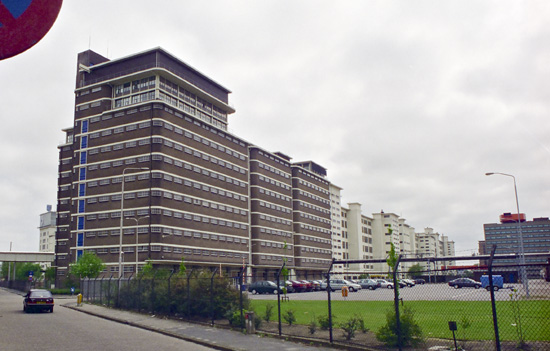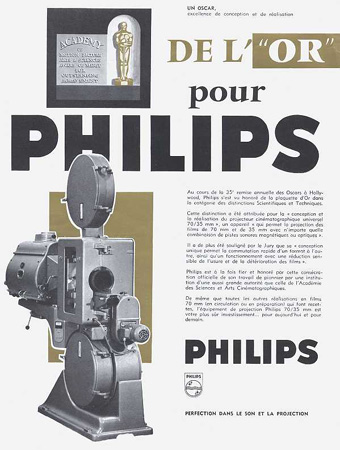|

“Almost like a real web
site”
|
IN7OMM.COM
• Search |
Contact
• News |
e-News |
• Rumour Mill |
Stories
• Foreign Language
• in70mm.com auf Deutsch
WHAT'S ON IN 7OMM?
7OMM FESTIVAL
• Todd-AO Festival
• KRRR! 7OMM Seminar
• GIFF 70, Gentofte
• Oslo 7OMM Festival
• Widescreen Weekend
TODD-AO
• Premiere |
Films
• People |
Equipment
• Library |
Cinemas
• Todd-AO Projector
• Distortion Correcting
PANAVISION
• Ultra Panavision
70
• Super Panavision
70
|
 |
|
VISION, SCOPE & RAMA
1926
Natural Vision
1929 Grandeur
1930 Magnifilm
1930 Realife
1930 Vitascope
1952 Cinerama
1953
CinemaScope
1955 Todd-AO
1955 Circle Vision
360
1956
CinemaScope 55
1957 Ultra
Panavision 70
1958 Cinemiracle
1958 Kinopanorama
1959 Super
Panavision 70
1959 Super Technirama 70
1960 Smell-O-Vision
1961 Sovscope
70
1962
Cinerama 360
1962 MCS-70
1963 70mm Blow Up
1963 Circarama
1963 Circlorama
1966 Dimension 150
1966
Stereo-70
1967 DEFA 70
1967 Pik-A-Movie
1970 IMAX / Omnimax
1974 Cinema
180
1974 SENSURROUND
1976 Dolby Stereo
1984 Showscan
1984 Swissorama
1986 iWERKS
1989 ARRI 765
1990 CDS
1994 DTS / Datasat
2001
Super Dimension 70
2018 Magellan 65
•
Various Large format
| 70mm to 3-strip |
3-strip to 70mm |
Specialty Large Format |
Special Effects in 65mm |
ARC-120 |
Super Dimension 70
| Early Large Format
• 7OMM Premiere in
Chronological Order
7OMM FILM & CINEMA
• Australia |
Brazil
• Canada |
Denmark
• England |
France
• Germany |
Iran
• Mexico |
Norway
• Sweden |
Turkey
• USA
LIBRARY
• 7OMM Projectors
• People |
Eulogy
• 65mm/70mm Workshop
• The 7OMM Newsletter
• Back issue |
PDF
• Academy of the WSW
7OMM NEWS
• 2026 | 2025 | 2024
• 2023 |
2022 |
2021
• 2020 |
2019 |
2018
• 2017 |
2016 |
2015
• 2014 |
2013 |
2012
• 2011 |
2010 | 2009
• 2008 | 2007 |
2006
• 2005 | 2004 |
2003
• 2002 |
2001 |
2000
• 1999 |
1998 |
1997
• 1996 |
1995 |
1994
|
|
in70mm.com Mission:
• To record the history of the large format movies and the 70mm cinemas
as remembered by the people who worked with the films. Both during
making and during running the films in projection rooms and as the
audience, looking at the curved screen.
•
in70mm.com, a unique internet based magazine, with articles about 70mm
cinemas, 70mm people, 70mm films, 70mm sound, 70mm film credits, 70mm
history and 70mm technology. Readers and fans of 70mm are always welcome
to contribute.
•
Disclaimer |
Updates
• Support us
• Testimonials
• Table of Content
|
| |
| |
Extracts and longer
parts of in70mm.com may be reprinted with the written permission from
the editor.
Copyright © 1800 - 2070. All rights reserved.
Visit biografmuseet.dk about Danish cinemas

|
| |
A
Brief History of Philips Cinema
|
This article first appeared in
..in 70mm
The 70mm Newsletter |
|
Written by:
C.
G. Nijsen, writer and historian |
Issue 62 - September 2000 |
|
 Mr
Anton Kotte (left)and Mr. Nijsen photographed in May 1998 in Eindhoven, Holland by Thomas
Hauerslev Mr
Anton Kotte (left)and Mr. Nijsen photographed in May 1998 in Eindhoven, Holland by Thomas
Hauerslev
The
Philips Light bulb factory was founded in 1891 by the two Philips brothers (Ing.
Gerard Philips and Dr. Anton Philips. Gerard was the technician and Anton
the salesman). When the "Philips" brand became so successful, they
decided during the 1920s, to enlarge their scope from lamps only to
everything electrical or electronic. Laboratory research was largely
concentrated on radio reception and transmitting. Around 1927 Philips
introduced a number of modern radio receivers on to the market that
triggered a whole range of other industrial activities.
Radio
meant Sound and Music. The existence of sound amplification
(a radio consists mainly of a receiver and an amplifier part, plus a
loudspeaker) logically led to further research into sound-on-film for
talking pictures. The Philips-Miller sound recording system was the
beginning of the Philips Electro-Acoustics Division (The division was
known
under other names during the early days).
Jan
Jacob Kotte
joined Philips as a young man and soon got involved in machine
design for these type of activities. The first "Loeftaffon" record
turntables to be synchronised with non-Philips film projectors were produced
in small numbers in a laboratory workshop (Called Proeffabriek). In the
early 1930s the first models of Philips projection machines and
Philips-Miller sound recording units were designed and constructed. Kotte
was the ace designer right from the start, guided by capable senior
engineers like Hardenberg, Nillesen and others. The famous, very modern
engineered Film Projectors FP5, 6 and 7 were introduced around 1937, and
still produced basically unaltered thirty years later!
|
Further in 70mm reading:
Jan Jacob Kotte
Gallery: May 1998:
Visiting Anton Philip Kotte in Eindhoven, Holland
Personnel
at ELA
DP70 / Universal 70-35 / Norelco
AAII - The Todd-AO Projector
Internet link:
|
 On
top of this Philips building in Eindhoven, Holland, all Philips´ cinema
projectors were enginered. The location was called "ELA" which
is short for Electro Acoustive Division. There was a cinema in which the
cinema equipment was installed, including a DP70. Picture by Editor. On
top of this Philips building in Eindhoven, Holland, all Philips´ cinema
projectors were enginered. The location was called "ELA" which
is short for Electro Acoustive Division. There was a cinema in which the
cinema equipment was installed, including a DP70. Picture by Editor.
Another
constructional master piece connected with Kotte´s name was the portable
35mm projector, designed secretly during the war in a small village hide-out
(Acht) and tested and launched in the year 1945. I was involved in both
projects and remember the surprise of all people in the movie business. The
name and logo "Philips Cinema" and my slogan "Philips for
Perfection in Sound and Projection" were coined during that period,
because our exporting activities had re-begun and we wanted to create an
international flavour for our activities in English-speaking territories. It
was soon followed by German, French and Spanish ("Siempre preferido por
Imagen y Sonido"), since new orders came in very quickly.
Germany
became a big market, since many cinemas had been destroyed during the war.
Strong competitors like Bauer, Ernemann, Siemens and Frieske & Höpfner
were gradually pushed out of the market by Philips´ quality and modern
design. Kalee, in spite of their old-fashioned type of engineering, was a
strong brand in England. Much later Cinemeccanica in Italy offered low-price
competition. Export to the USA, competing with Simplex and Century, on a
well-protected home market, was considered too difficult for the time being.
|
|
Philips
ELA
(Electro
Acoustics)
|
|
|
 The
Philips "ELA" name was coined in 1946 when the manufacturing and
selling activities of microphones, amplifiers, PA loudspeakers (Public
Address), recording and cinema equipment were concentrated into one
division. The
Philips "ELA" name was coined in 1946 when the manufacturing and
selling activities of microphones, amplifiers, PA loudspeakers (Public
Address), recording and cinema equipment were concentrated into one
division.
There
was a split-up of responsibilities: The "Factory" taking care of
development, construction and manufacturing, and the "Commercial
Department" being in charge of marketing, planning and sales, plus
keeping in touch with international markets and sales representatives
(Philips and non-Philips products) abroad.
Commercially
responsible for cinema
activities were:
*
H. Opdenberg, Commercial Director
* H. A. H. M. Nillesen, Commercial Director Cinema Department (later
succeeded by H. L. A. Gimberg.)
* W. Jansen, Technical-Commercial liason officer
* C.G.Nijsen, Sales Promotion & Advertising Manager
* G. Hooghiemstra, Sales Representative USA area
Technically
responsible for cinema activities were:
*
Dr. J. de Boer, Technical Director (successor to H. Wildeboer)
* P. Hinse, Manager Cinema Design Department
* Jan J. Kotte, Chief Designer
* P. Hoekstra, Designer Special Projects
* A.A. Overmars, Manager Projector Assembly Department
The
latter people also communicated with parts manufacture such as Philips
Machine and Metalware factories.
Personnel
beyond the above mentioned organisations and engaged in DP70 activities were
J. Sliepenbeek, F. Rijke, H. de Laart, and others involved in the rushed
DP70 planning.
Later,
C. Cessler was employed as a sales representative for the Holland area, as
well as in other nearby countries.
After
1973, international sales of Philips Cinema equipment were handled on an
exclusive basis by the firm of Kinoton GmbH in Munich, Germany. Since 1973
Kinoton GmbH have continued to order Philips
Cinema projectors from the Eindhoven Machine factory (Machinenfabriek
8). After Jan Kotte's retirement he continued working for Mr. Zoller, chief
of Kinoton, making projector design for them.
|
|
|
|
|
Go: back
- top - back issues
Updated
21-01-24 |
|
|
 On
top of this Philips building in Eindhoven, Holland, all Philips´ cinema
projectors were enginered. The location was called "ELA" which
is short for Electro Acoustive Division. There was a cinema in which the
cinema equipment was installed, including a DP70. Picture by Editor.
On
top of this Philips building in Eindhoven, Holland, all Philips´ cinema
projectors were enginered. The location was called "ELA" which
is short for Electro Acoustive Division. There was a cinema in which the
cinema equipment was installed, including a DP70. Picture by Editor.

 The
Philips "ELA" name was coined in 1946 when the manufacturing and
selling activities of microphones, amplifiers, PA loudspeakers (Public
Address), recording and cinema equipment were concentrated into one
division.
The
Philips "ELA" name was coined in 1946 when the manufacturing and
selling activities of microphones, amplifiers, PA loudspeakers (Public
Address), recording and cinema equipment were concentrated into one
division.